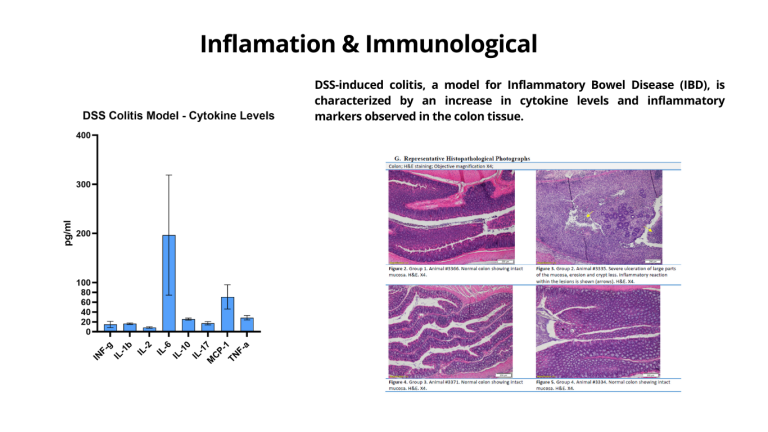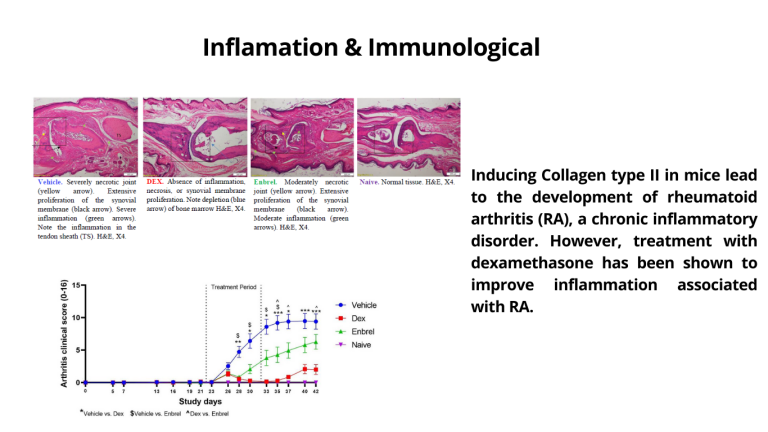Preclinical research in rodent models is an indispensable tool for unraveling the complexities of inflammation and immunology. A wide range of immune-relevant mouse model strains provides valuable insight into organ- and tissue-dependent immune responses. Immunological research examines interaction between immune cells, cytokine signaling pathways, the impact of inflammatory mediators on tissue homeostasis, and the underlying causes of autoimmune diseases, allergies, and inflammatory conditions. These models allow the development and evaluation of new therapeutic interventions to modulate immune responses and control inflammation, and help address the clinical challenges of these fields.
At Vivox, our unique approach to studying inflammation and immunology incorporates scientific expertise, advanced surgical techniques, and meticulous research protocols that adhere to GLP standards.
The following models for drug candidates and immunological research are available at Vivox:
Our services support a variety of therapeutic areas

Microbiome

Cell- & Gene- based therapies

Biological therapies

Cannabis-based therapies

Pharmaceuticals

Nutraceuticals

Medical devices
Inflammatory and Immunological Models
MOG-Induced EAE (MS) Model
Multiple sclerosis (MS) is an autoimmune disease in which neuroinflammatory demyelination of the central nervous system (CNS) is a hallmark feature. Experimental autoimmune encephalomyelitis (EAE) is considered as a standard animal model used to test novel therapeutics targeting the inflammatory component of MS.
Vivox performs an EAE model in C57BL/6 strain mice in which animals are immunized with MOG33-55, a CNS-specific transmembrane myelin glycoprotein, together with pertussis toxin (PT), leading to chronic disease charaterized by a relapsing-remitting pattern resembling the most common form of human MS. MOG33-55 immunization results in monophasic EAE, with the first symptoms developing within 9-14 days and reaching peak disease within 3-5 days from disease onset, followed by a slow, partial recovery of symptoms over the subsequent 10-20 days.

PLP-Induced EAE (MS) Model
The PLP-induced Experimental Autoimmune Encephalomyelitis (EAE) model is a widely used preclinical model for studying multiple sclerosis (MS) and autoimmune neuroinflammatory diseases. In this model, myelin oligodendrocyte glycoprotein peptide (PLP) is used to induce an immune response targeting the central nervous system, leading to demyelination, inflammation, and neurological deficits similar to those seen in MS patients.
Vivox’s expertise in the PLP-induced EAE model allows for detailed investigations into disease mechanisms, immune responses, neuroinflammation, and potential therapeutic interventions targeting MS and related autoimmune conditions. This research contributes to advancing our understanding of MS pathogenesis and developing novel treatments to improve patient outcomes.

Delayed-Type Hypersensitivity (DTH) Model
Vivox’s in-vivo department utilizes the oxazolone-induced Delayed-Type Hypersensitivity (DTH) model as a robust tool for studying immune-mediated reactions. By inducing localized hypersensitivity responses using oxazolone, we are able to mimic aspects of DTH seen in allergic and autoimmune disorders. This model enables us to investigate immune-system responses, involved inflammatory pathways, and potential therapeutic interventions with greater precision, contributing to advancements in understanding hypersensitivity disorders and developing targeted treatments in immunology research at Vivox.
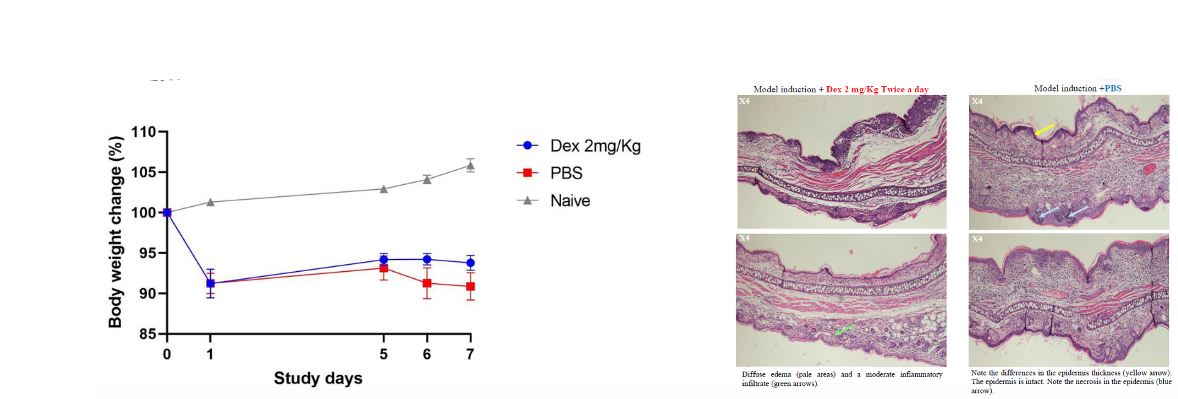
Dextran Sulfate Sodium (DSS)-Induced Colitis
Inflammatory Bowel Disease (IBD) Model
DSS (dextran sulfate sodium) is a compound commonly used to induce colitis in animal models, mimicking aspects of human inflammatory bowel disease (IBD). Vivox’s uniqueness in experiments in this field lies in its innovative approach to developing and utilizing DSS-induced colitis models. By employing sophisticated techniques and specialized methodologies, Vivox enables researchers to study the mechanisms underlying colitis, explore potential therapeutic interventions, and contribute to advancements in understanding and treating IBD.
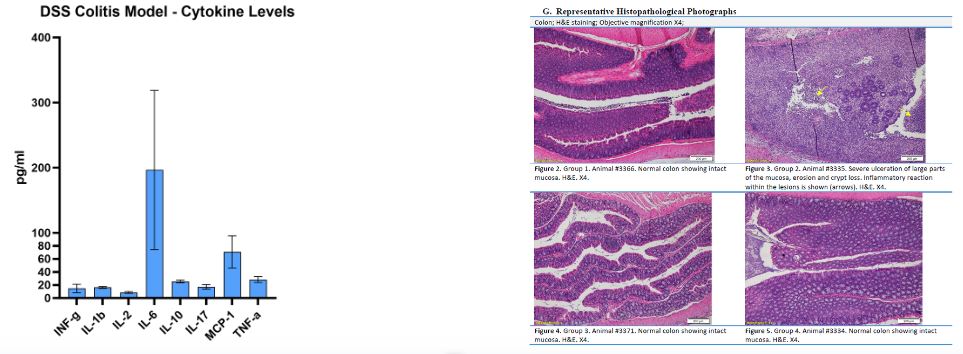
TNBS-Induced Crohn’s Disease (CD) IBD Model
In Vivox’s in vivo department, the 2,4,6-trinitrobenzenesulfonic acid (TNBS)-induced colitis model serves as a valuable tool for studying Crohn’s Disease (CD) and inflammatory bowel diseases (IBD). Our experienced researchers utilize this model to mimic the inflammatory responses and pathological features characteristic of CD, including intestinal mucosal damage, immune cell infiltration, and cytokine dysregulation. Through careful induction protocols and comprehensive assessments, we can evaluate the efficacy of potential interventions, investigate underlying disease mechanisms, and help develop novel treatment strategies for managing CD and related gastrointestinal disorders. Vivox’s in-vivo expertise in the TNBS-induced colitis model contributes to advancing IBD research and improving patient outcomes.
Cecal Ligation and Puncture (CLP) Sepsis Model
In this model, the cecum is surgically ligated to create a closed-loop obstruction, mimicking a ruptured appendix or other intra-abdominal infections. Then, the cecum is punctured with a needle, allowing fecal matter to leak into the abdominal cavity, initiating a severe systemic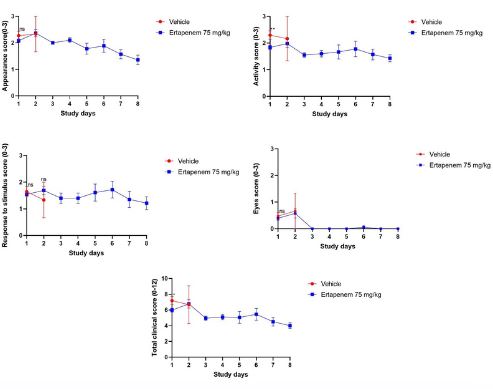 inflammatory response resembling sepsis. This model allows researchers to study various aspects of sepsis pathophysiology, including inflammation, organ dysfunction, and potential therapeutic interventions.
inflammatory response resembling sepsis. This model allows researchers to study various aspects of sepsis pathophysiology, including inflammation, organ dysfunction, and potential therapeutic interventions.
Vivox excels in utilizing the CLP model for sepsis research thanks to its multidisciplinary team of experts, state-of-the-art facilities, and cutting-edge technologies. This combination allows for precise CLP experiments, detailed immune response characterization, and collaborative partnerships, ultimately accelerating the development of novel sepsis treatments.

Imiquimod-Induced Psoriasis Model
In this Psoriasis model, mice are treated with the chemical compound Imiquimod, a toll-like receptor 7 (TLR7) agonist that, when applied topically to the skin, triggers an inflammatory response resembling psoriasis. This model induces psoriasis-like skin lesions characterized by erythema and scaling, and replicates key histopathological features of human psoriasis, such as epidermal hyperplasia, immune cell infiltration, and cytokine dysregulation. The use of psoriasis models are valuable to the investigation of the pathogenesis and underlying mechanisms of psoriasis.
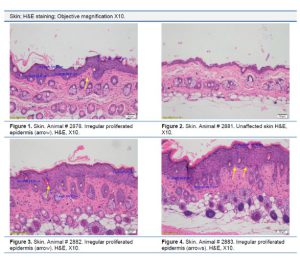
Oxazolone-Induced Contact Dermatitis
Oxazolone-induced contact dermatitis is a widely used model in preclinical research for studying allergic skin reactions and immune-mediated dermatological disorders. This model involves sensitizing the skin with oxazolone, leading to an inflammatory response characterized by erythema, edema, and leukocyte infiltration.
Vivox’s expertise in the oxazolone-induced contact dermatitis model allows for comprehensive investigations into inflammatory pathways, immune responses, and potential therapeutic interventions for skin disorders, contributing to advancements in dermatology research and drug development.
Systemic Lupus Erythematosus (SLE) Model
Systemic lupus erythematosus (SLE) models in mice are used to investigate the autoimmune disease lupus in humans. These models involve genetically modifying mice to mimic certain aspects of lupus seen in humans, such as autoantibody production, immune system dysfunction, and tissue damage. There are several types of SLE mouse models, including spontaneous models, induced models, and genetically engineered models.
Vivox specializes in using SLE models to study autoimmune mechanisms and develop targeted therapies, employing advanced techniques for comprehensive analysis. Collaboration with experts and partners helps advance SLE research and treatment development.
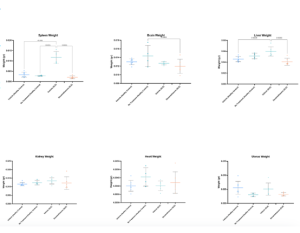
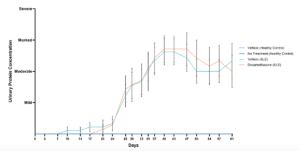
LPS-Induced Acute Lung Inflammation (Neutrophilia) Model
The lipopolysaccharide (LPS)-induced acute lung inflammation (neutrophilia) model is a valuable tool in preclinical research for studying inflammatory lung diseases and immune responses. This model involves the administration of LPS to induce rapid neutrophil infiltration into the lungs, mimicking aspects of acute lung injury and inflammation.
Vivox presents expertise in the LPS-induced acute lung inflammation model, which enables detailed investigations into inflammatory pathways, immune cell recruitment, cytokine responses, and potential therapeutic strategies for lung disorders. This research contributes to the development of novel treatments and interventions to manage acute lung inflammation and improve respiratory health outcomes.
Bleomycin-Induced Idiopathic Pulmonary Fibrosis (IPF) Model
In Vivox’s in vivo department, the bleomycin-induced lung fibrosis model serves as a crucial platform for studying idiopathic pulmonary fibrosis (IPF), a progressive lung disease characterized by excessive deposition of extracellular matrix proteins in the lung parenchyma, and related fibrotic lung diseases. In this model, mice are typically intratracheally instilled with bleomycin, a cytotoxic agent known to induce lung injury and fibrosis. After bleomycin administration, mice develop histological features resembling human IPF, including inflammation, fibroblast proliferation, collagen deposition, and progressive lung scarring.
Vivox’s expertise in this model helps investigate the pathogenesis of pulmonary fibrosis, advance research in respiratory medicine, test potential therapeutic interventions, and explore underlying mechanisms involved in fibrosis development and progression.
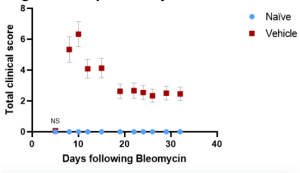

Collagen-Induced Arthritis (CIA) Model
Type II Collagen-Induced Arthritis (CIA) is a widely used experimental model for studying rheumatoid arthritis (RA) in animals. It involves the induction of arthritis by immunization with type II collagen, leading to joint inflammation and destruction similar to RA in humans. Vivox’s uniqueness in experiments in this field stems from its innovative approaches in developing and utilizing CIA models. Through advanced techniques and specialized protocols, Vivox enables researchers to investigate the pathogenesis of RA, evaluate potential therapeutic interventions, and contribute to the development of novel treatments for this autoimmune disease.
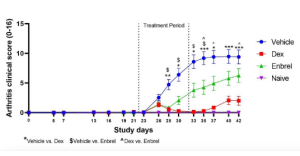
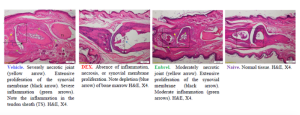
Experimental Uveitis
Skin Inflammation Screening Tests
Customized Rodent Immunization Protocols
Research Outcomes - Examples
